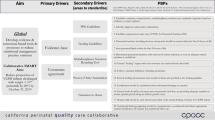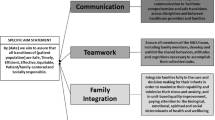Abstract
Objectives
The authors sought to measure and compare practice preference variation in neonatal respiratory care within and between neonatal intensive care units (NICUs) using the Neonatology Survey of Interdisciplinary Groups in Healthcare Tool (NSIGHT).
Study design
Eleven NICUs completed the NSIGHT between 2019 and 2021. Net preference was measured by mean response; agreement was ranked by standard distribution of response values. Heat maps showed comparisons between NICUs and disciplines.
Results
NICUs and individuals agreed most often on use of pressure support with mandatory ventilation and on use of non-invasive positive pressure ventilation for apnea. High preference variation surrounded decisions for invasive ventilation versus continuous positive airway pressure for extremely low birth weight infants. Preference difference was most frequent between neonatologists and nurses.
Conclusions
Patterns of practice preference variation in neonatal respiratory care are specific to clinical scenario. Measuring preference variation may inform psychology of change and strengthen quality improvement efforts.
This is a preview of subscription content, access via your institution
Access options
Subscribe to this journal
Receive 12 print issues and online access
$259.00 per year
only $21.58 per issue
Buy this article
- Purchase on Springer Link
- Instant access to full article PDF
Prices may be subject to local taxes which are calculated during checkout



Similar content being viewed by others
Data availability
The dataset generated during the current study is not publicly available as it contains information that identifies the participating site. Data is available from the corresponding author on reasonable request.
References
Vermont Oxford Network. Very Low Birth Weight Database [Available from: https://public.vtoxford.org/data-and-reports/vlbw-database/.
Ehrenkranz RA, Walsh MC, Vohr BR, Jobe AH, Wright LL, Fanaroff AA, et al. Validation of the National Institutes of Health consensus definition of bronchopulmonary dysplasia. Pediatrics. 2005;116:1353–60.
Guaman MC, Gien J, Baker CD, Zhang H, Austin ED, Collaco JM. Point prevalence, clinical characteristics, and treatment variation for infants with severe bronchopulmonary dysplasia. Am J Perinatol. 2015;32:960–7.
Abman SH, Collaco JM, Shepherd EG, Keszler M, Cuevas-Guaman M, Welty SE, et al. Interdisciplinary care of children with severe bronchopulmonary dysplasia. J Pediatr. 2017;181:12–28.e1.
Gien J, Kinsella J, Thrasher J, Grenolds A, Abman SH, Baker CD. Retrospective analysis of an interdisciplinary ventilator care program intervention on survival of infants with ventilator-dependent bronchopulmonary dysplasia. Am J Perinatol. 2017;34:155–63.
Smith VC, Zupancic JA, McCormick MC, Croen LA, Greene J, Escobar GJ, et al. Rehospitalization in the first year of life among infants with bronchopulmonary dysplasia. J Pediatr. 2004;144:799–803.
Horbar JD, Carpenter JH, Badger GJ, Kenny MJ, Soll RF, Morrow KA, et al. Mortality and neonatal morbidity among infants 501 to 1500 grams from 2000 to 2009. Pediatrics. 2012;129:1019–26.
Horbar JD, Greenberg LT, Buzas JS, Ehret DEY, Soll RF, Edwards EM. Trends in mortality and morbidities for infants born 24 to 28 weeks in the US: 1997–2021. Pediatrics. 2024;153:e2023064153.
Payne NR, LaCorte M, Sun S, Karna P, Lewis-Hunstiger M, Goldsmith JP. Evaluation and development of potentially better practices to reduce bronchopulmonary dysplasia in very low birth weight infants. Pediatrics. 2006;118 Suppl 2:S65–72.
Horbar JD, Edwards EM, Greenberg LT, Morrow KA, Soll RF, Buus-Frank ME, et al. Variation in performance of neonatal intensive care units in the United States. JAMA Pediatr. 2017;171:e164396.
Boghossian NS, Geraci M, Lorch SA, Phibbs CS, Edwards EM, Horbar JD. Racial and ethnic differences over time in outcomes of infants born less than 30 weeks’ gestation. Pediatrics. 2019;144:e20191106.
Beltempo M, Isayama T, Vento M, Lui K, Kusuda S, Lehtonen L, et al. Respiratory management of extremely preterm infants: an international survey. Neonatology. 2018;114:28–36.
Mukerji A, Shah PS, Shivananda S, Yee W, Read B, Minski J, et al. Survey of noninvasive respiratory support practices in Canadian neonatal intensive care units. Acta Paediatr. 2017;106:387–93.
Healy H, Croonen LEE, Onland W, van Kaam AH, Gupta M. A systematic review of reports of quality improvement for bronchopulmonary dysplasia. Semin Fetal Neonatal Med. 2021;26:e101201.
Walsh M, Laptook A, Kazzi SN, Engle WA, Yao Q, Rasmussen M, et al. A cluster-randomized trial of benchmarking and multimodal quality improvement to improve rates of survival free of bronchopulmonary dysplasia for infants with birth weights of less than 1250 grams. Pediatrics. 2007;119:876–90.
Deming WE The New Economics for Industry, Government, Education. 3rd ed. Cambridge, Massachusetts: The Massachusettes Institute of Technology Press; 2018.
Whitesel E, Healy H, Mao W, Pursley DM, Zupancic J, Gupta M. Measuring practice preference variation for quality improvement: development of the Neonatology Survey of Interdisciplinary Groups in Healthcare Tool (NSIGHT). BMJ Open Qual. 2023;12:e002422.
Harris PA, Taylor R, Minor BL, Elliott V, Fernandez M, O’Neal L, et al. The REDCap consortium: building an international community of software platform partners. J Biomed Inf. 2019;95:103208.
Harris PA, Taylor R, Thielke R, Payne J, Gonzalez N, Conde JG. Research electronic data capture (REDCap)-a metadata-driven methodology and workflow process for providing translational research informatics support. J Biomed Inf. 2009;42:377–81.
Whitesel E, Healy H, Mao W, Pursley D, Gupta M, Zupancic JAF Measuring Practice Preference Variation for Quality Improvement: Development of the Neonatology Survey of Interdisciplinary Groups in Healthcare Tool (NSIGHT). Presently under consideration for publication. 2023.
Pearson TA, Manolio TA. How to interpret a genome-wide association study. JAMA. 2008;299:1335–44.
Reyes ZC, Claure N, Tauscher MK, D’Ugard C, Vanbuskirk S, Bancalari E. Randomized, controlled trial comparing synchronized intermittent mandatory ventilation and synchronized intermittent mandatory ventilation plus pressure support in preterm infants. Pediatrics. 2006;118:1409–17.
Finer NN, Carlo WA, Walsh MC, Rich W, Gantz MG, Laptook AR, et al. Early CPAP versus surfactant in extremely preterm infants. N Engl J Med. 2010;362:1970–9.
Morley CJ, Davis PG, Doyle LW, Brion LP, Hascoet JM, Carlin JB, et al. Nasal CPAP or intubation at birth for very preterm infants. N Engl J Med. 2008;358:700–8.
Rysavy MA, Li L, Bell EF, Das A, Hintz SR, Stoll BJ, et al. Between-hospital variation in treatment and outcomes in extremely preterm infants. N Engl J Med. 2015;372:1801–11.
Barrington KJ, Bull D, Finer NN. Randomized trial of nasal synchronized intermittent mandatory ventilation compared with continuous positive airway pressure after extubation of very low birth weight infants. Pediatrics. 2001;107:638–41.
Lemyre B, Davis PG, De Paoli AG, Kirpalani H. Nasal intermittent positive pressure ventilation (NIPPV) versus nasal continuous positive airway pressure (NCPAP) for preterm neonates after extubation. Cochrane Database Syst Rev. 2017;2:CD003212.
Ramaswamy VV, Bandyopadhyay T, Nanda D, Bandiya P, More K, Oommen VI, et al. Efficacy of noninvasive respiratory support modes as postextubation respiratory support in preterm neonates: A systematic review and network meta-analysis. Pediatr Pulmonol. 2020;55:2924–39.
Li W, Long C, Zhangxue H, Jinning Z, Shifang T, Juan M, et al. Nasal intermittent positive pressure ventilation versus nasal continuous positive airway pressure for preterm infants with respiratory distress syndrome: a meta-analysis and up-date. Pediatr Pulmonol. 2015;50:402–9.
Ramaswamy VV, More K, Roehr CC, Bandiya P, Nangia S. Efficacy of noninvasive respiratory support modes for primary respiratory support in preterm neonates with respiratory distress syndrome: Systematic review and network meta-analysis. Pediatr Pulmonol. 2020;55:2940–63.
Rogers EM Diffusion of Innovations. 5th ed: Simon and Schuster; 2003.
Institute of Medicine (U.S.). Committee on Quality of Health Care in America. Crossing the quality chasm : a new health system for the 21st century. Washington, D.C.: National Academy Press; 2001. xx, 337.
Balas EA, Boren SA. Managing clinical knowledge for health care improvement. Yearb Med Inform. 2000:65–70.
Author information
Authors and Affiliations
Contributions
HH, EW, JAFZ, and MG, conceptualized and designed the study, including the vignettes used, drafted the initial manuscript, carried out the initial analyses, and critically reviewed and revised the manuscript. WM researched and developed analyses methods and designed and produced visual representation heat maps, as well as contributed to drafting of the original manuscript. CLD, TGM, CHS, PKW, SSB, PC, RJV, SC, PA, MB, and DWS, all recruited participants, collected data, contributed to data interpretation, and critically reviewed and revised the manuscript. All authors approved the final manuscript as submitted and agree to be accountable for all aspects of the work.
Corresponding author
Ethics declarations
Competing interests
The authors declare no competing interests.
Additional information
Publisher’s note Springer Nature remains neutral with regard to jurisdictional claims in published maps and institutional affiliations.
Supplementary information
Rights and permissions
Springer Nature or its licensor (e.g. a society or other partner) holds exclusive rights to this article under a publishing agreement with the author(s) or other rightsholder(s); author self-archiving of the accepted manuscript version of this article is solely governed by the terms of such publishing agreement and applicable law.
About this article
Cite this article
Healy, H., Whitesel, E., Mao, W. et al. Measuring practice preference variation for quality improvement in neonatal respiratory care. J Perinatol (2024). https://doi.org/10.1038/s41372-024-01956-w
Received:
Revised:
Accepted:
Published:
DOI: https://doi.org/10.1038/s41372-024-01956-w



